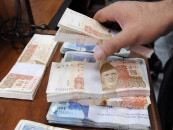ADB maintains 15% inflation forecast
Says economy faces slow growth amongst regional peers, elevated debt level

The Asian Development Bank (ADB) has maintained its inflation forecast for Pakistan at 15%, significantly higher than the official target, while predicting the country’s debt burden will ease to 70% of GDP this fiscal year.
The Manila-based lender’s flagship report, the Asian Development Outlook, did not provide a new economic growth figure for Pakistan, implying it retained the previous forecast of 2.8% growth for this fiscal year, lower than the official target of 3.5%.
This release coincides with another comprehensive report by BMI, the macro research engine of Fitch Solutions, which offered extensive commentary on Pakistan’s political regime, the fate of the current coalition government, and economic forecasts for the next decade.
“We expect Pakistan’s economy will underperform its key regional peers over the coming 10 years. Growth will average just 3.5% over the decade to FY2032-33, about half the pace of growth in Bangladesh or India,” noted BMI.
The ADB stated that Pakistan’s inflation forecasts for fiscal year 2025 remain the same as in the April 2024 report. In April, the ADB had mentioned that rising administered energy prices would keep inflation high at 15% for fiscal year 2024-25. The government has set the inflation target at 12% for this fiscal year, which many believe will be missed again due to unprecedented levels of new taxation and increases in energy and fuel prices.
While the ADB forecasts Pakistan’s economic growth at just 2.8% and inflation at 15%, it projects India’s economy to grow at 7.2% with an inflation rate of 4.5% for fiscal year 2024-25.
The ADB also stated that Pakistan’s public debt is expected to decline by seven percentage points to 70% of GDP in fiscal year 2024-2025. “Still, interest payments are expected to require a staggering 62% of fiscal revenues, up from 41% in 2022-2023,” noted the lender. However, these figures do not fully represent the true cost of debt servicing. For this fiscal year, the government has allocated Rs9.8 trillion for interest payments, which equals 76% of the FBR’s tax target of nearly Rs13 trillion.
Even at a 70% debt level, Pakistan’s debt burden will be significantly higher than the average 47% government debt-to-GDP ratio for developing Asia this year. The ADB mentioned that despite gradual improvement, some high-risk countries remain in a difficult position. In contrast to the ADB’s 70% debt-to-GDP projection, Fitch Solutions projected the level at 78% of GDP – five percentage points higher than this fiscal year.
BMI Fitch Solutions highlighted that the depreciation of the Pakistani rupee in 2022 and 2023 raised concerns about the sustainability of Pakistan’s external debt. Although the country managed to roll over significant debt payments in mid-2023, it has not addressed the underlying problem.
“We forecast that Pakistani policymakers and their international partners will succeed in avoiding an acute debt crisis, but we think the country's debt levels will remain elevated over the next 10 years,” stated BMI. Pakistan is currently under an IMF programme that has reduced prospects for healthy growth, potentially increasing unemployment and poverty. These grim outcomes are also reflected in BMI’s report, which states that Pakistan will continue to underperform its regional peers in the coming years.
“Between 2023/24 and 2032/33, we expect growth in the country to average just 3.5%, compared to 5.4% in emerging markets,” the BMI report noted. This comparatively poor performance will see Pakistan’s GDP per capita fall further behind India’s. Whereas Pakistan’s GDP per capita was 78% of India’s in 2019, this ratio is expected to drop to 51% by 2032, it added.
BMI also commented on Pakistan’s political system and the legal battles faced by Imran Khan. “Despite several successful legal appeals, opposition leader Imran Khan will remain imprisoned for the foreseeable future. We expect the PML(N)-led government will remain in power over the next 18 months and will succeed in implementing IMF-mandated fiscal reforms.”
BMI mentioned that Pakistan’s economy remains very fragile in the face of external shocks. Given that 40% of Pakistanis work in agriculture, another flood or drought would pose a significant risk to the economy. The fragile political situation could also derail recovery. The strong electoral performance of independent candidates backed by jailed opposition leader Imran Khan indicates significant dissatisfaction with the current political elite. Another round of protests in urban areas could disrupt economic activity, according to BMI.
It said, the present political administration, lacking popular support, faces the daunting challenge of managing an economy recovering from the 2022-23 crisis while addressing fragile security concerns. “Further protests by Khan’s supporters – many of whom believe their party has been targeted by Pakistan’s establishment – are likely,” according to BMI.


















COMMENTS
Comments are moderated and generally will be posted if they are on-topic and not abusive.
For more information, please see our Comments FAQ